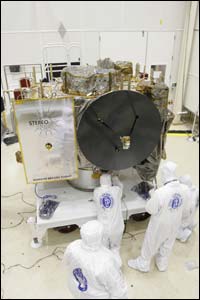Coming soon: The sun in 3-D

Technicians and engineers at the Johns Hopkins University Applied Physics Laboratory (APL), in Laurel, Md., prepare one of the twin STEREO (Solar TErrestrial RElations Observatory) spacecraft for shipment to NASA Goddard Space Flight Center for additional pre-launch tests. Credit: Johns Hopkins University Applied Physics Laboratory.
Twin APL-built solar probes shipped to NASA Goddard for pre-launch tests
The first spacecraft designed to capture 3-D “stereo” views of the sun and solar wind were shipped today from the Johns Hopkins University Applied Physics Laboratory (APL) in Laurel, Md., to NASA Goddard Space Flight Center (GSFC) in Greenbelt, Md., for their next round of pre-launch tests.
The nearly identical twin STEREO (Solar TErrestrial RElations Observatory) observatories, designed and built by APL, were recently tested in APL’s vibration lab where engineers used a large shake table to check the structural integrity of the twin spacecraft. These tests simulate the ride into space the observatories will encounter aboard a Delta II launch vehicle from Cape Canaveral Air Force Station, Fla., where they’re scheduled for launch in spring 2006.
“Delivery of the twin observatories to NASA is a program milestone,” says Ed Reynolds, APL STEREO project manager. “Building two nearly identical spacecraft simultaneously was a technical and scheduling challenge, but one our team welcomed and tackled with extreme professionalism and dedication. With the design, construction and now delivery of the observatories to NASA Goddard, we’re very excited to help NASA get one step closer to launch and capturing the first-ever 3-D images of the sun.”
During the next three months at NASA GSFC, the twin observatories will undergo additional pre-launch checks including a series of spin tests to check the spacecraft’s balance and alignment; thermal vacuum tests to duplicate the extreme temperature and airless conditions of space; and acoustic tests that simulate the noise-induced vibrations of launch. The mission team plans to transport the STEREO observatories to Florida in March 2006 for final launch preparations.
Swinging into Orbit
During the two-year STEREO mission, two nearly identical space-based observatories will explore the origin, evolution and interplanetary consequences of coronal mass ejections. These powerful solar eruptions are a major source of the magnetic disruptions on Earth and a key component of space weather, which can greatly affect satellite operations, communications, power systems, and the lives of humans in space.
To obtain unique “stereo” views of the sun, the twin STEREO observatories must be placed into different orbits where they’re offset from each other and the Earth. One observatory will be placed ahead of Earth in its orbit around the sun and the other behind. Just as the slight offset between your eyes provides you with depth perception, this placement will allow the STEREO observatories to obtain 3-D images and particle measurements of the sun.
“This is the first time lunar swingbys will be used to place multiple spacecraft into their respective orbits,” says APL’s Andy Driesman, STEREO system engineer. “Mission designers at APL will use the moon’s gravity to redirect the observatories to their appropriate orbits around the sun. This innovative mission design allows the use of a single launch vehicle.”
After launch, the observatories will fly in an orbit from a point close to Earth to one that extends just beyond the moon. Approximately two months later, mission operations personnel at APL will synchronize spacecraft orbits, directing one observatory to its position trailing Earth in its orbit. Approximately one month later, the second observatory will be redirected to its position ahead of Earth.
STEREO is the third mission in NASA’s Solar Terrestrial Probes Program. STEREO is sponsored by NASA’s Science Mission Directorate in Washington, D.C. NASA GSFC’s Solar Terrestrial Probes Program Office manages the mission, instruments and science center. APL designed, built and will operate the twin observatories for NASA during the mission.
Media Contact
More Information:
http://www.jhuapl.eduAll latest news from the category: Physics and Astronomy
This area deals with the fundamental laws and building blocks of nature and how they interact, the properties and the behavior of matter, and research into space and time and their structures.
innovations-report provides in-depth reports and articles on subjects such as astrophysics, laser technologies, nuclear, quantum, particle and solid-state physics, nanotechnologies, planetary research and findings (Mars, Venus) and developments related to the Hubble Telescope.
Newest articles

“Nanostitches” enable lighter and tougher composite materials
In research that may lead to next-generation airplanes and spacecraft, MIT engineers used carbon nanotubes to prevent cracking in multilayered composites. To save on fuel and reduce aircraft emissions, engineers…

Trash to treasure
Researchers turn metal waste into catalyst for hydrogen. Scientists have found a way to transform metal waste into a highly efficient catalyst to make hydrogen from water, a discovery that…

Real-time detection of infectious disease viruses
… by searching for molecular fingerprinting. A research team consisting of Professor Kyoung-Duck Park and Taeyoung Moon and Huitae Joo, PhD candidates, from the Department of Physics at Pohang University…





















